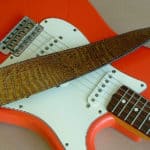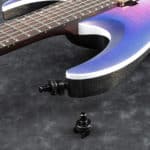Guitar players have a lot to worry about: staying in tune, hitting the right notes, making sure our hair is just right, and other such things.
The last thing we need to worry about is our guitar coming loose from its strap and letting gravity win… again.
Here are 6 ways to prevent your guitar strap from falling off:
- Proper maintenance of your strap pins
- Upgrade your strap
- Use a locking system to hold your strap
- Use a strap with a built-in locking system
- Use a locking strap pin
- Duct tape!
So strap in!
(*rimshot*)
We’re going for a ride!
What causes guitar straps to come off?
The biggest culprit for guitar straps coming off is normal wear and tear from regular use.
Depending on the quality of the guitar strap, the holes where the strap pins go can stretch out and widen, causing them to no longer snug onto the strap pin.
The actual quality of the materials used to make the strap can accelerate this wear and tear.
Budget straps (typically those under $30) are made of cheaper materials that can wear out faster than their more pricey brethren.
It may be worth it to drop a few extra dollars on a higher quality one made of better and more durable materials.
Wear and tear can also be attributed to the other culprit, how you move during a performance.
If you play in a very animated punk or metal band (or your acoustic folk band rocks out with the intensity of a Black Flag show; we’re not here to judge), the odds of your strap coming off as you flail about on stage are much higher.
The other things that wear and tear will affect are the actual strap pins themselves.
Over time, their use can result in the screws coming loose, or eventually stripping away from the holes.
Much like the straps, this can be exacerbated by the use of the instrument (even with the less animated of performances), and the quality of the woods or hardware (guitars made with softer woods will wear out a bit faster).
6 ways to prevent your guitar strap from falling off
1. Stay on top of maintenance if you notice your pins are loose
Sometimes you just need to give them a tighten and you’re good to go.
If they get really loose, you can always employ the handy “toothpick and glue” repair hack.
This is where you break a couple of toothpicks the length of the depth of the strap pin’s hole, insert them into the hole, and add glue (just be careful of the guitar’s body and finish around the hole).
The added wood from the toothpicks will give something for the screws to bite onto.
If the problem goes beyond that, it is best to take the instrument to a qualified guitar repairman to have the hole properly fixed.
This will usually involve the repairman using a dowel to fill the hole and reinstall the strap pin.
2. Upgrade your strap
As mentioned earlier, better materials make for a better strap, and this may be a case to justify the added expense.
You’ll want to look for something that is made of quality leather, rather than the cheap (and often imitation) leather used on budget guitar straps (basically anything under $20 on Amazon – avoid like the plague!).
Straps by Levy, Mono, and the higher-priced straps from Fender and Gibson would fall into this category, among others. Shop around!
3. Use a locking system that holds the strap onto your guitar
Several means of holding your strap in place now exist on the market.
There are the rubber strap locks from companies like Fender that basically go onto the strap pin after the strap is on, helping it stay in place (players like Joe Bonamassa use these for his very, very, very expensive guitars), or the plastic locking washers such as the DiMarzio Dual Lock strap locks.
The catch is that they can be difficult to put on or off your guitar unless you’re the player that keeps their strap on their guitar all the time.
The biggest pro is that you can use your favorite strap, no problem!
4. Use a strap with a built-in locking system
These have appeared over the last few years and have proven to be quite popular.
These straps, such as the Ernie Ball Neoprene Polylock strap and DiMarzio’s Clip lock strap, have systems that secure the strap without making permanent modifications to your instrument.
The catch is that if you don’t like the look of the strap, you’re either stuck with it or you just don’t use it.
5. Use a locking strap pin
Probably the most secure means of keeping your strap from falling, these systems (such as the famous Schaller S-Locks and the Dunlop Straplok) employ a special strap pin and a lock mechanism on the strap itself.
Once together, it is very, very difficult (short of actually breaking them) to get the strap off. This is the epitome of strap security! Plus, this system will practically work with any strap!
But, it does come with a couple of catches. You do need to change the strap pins on your instrument to use a locking system.
Depending on your guitar, or level of comfort in installing such things, this will mean a trip to the luthier for proper installation.
And, depending on the system (such as the Schallers), you are stuck with using one particular strap with one specific guitar (or any guitar that employs the same system); you do not want to attach a regular strap to the Schaller buttons because the buttons will not (I repeat, NOT) hold a normal strap in place.
The same goes for the strap itself. The locks are not made to come off and on quickly, so your strap is pretty much tied to that guitar.
6. Duct tape!
That’s right, if it worked for Billie Joe Armstrong in the ’90s, it can work for you!
Nobody wants to see a guitar take a dive on stage, especially the player. With all of these options for keeping your strap in place, take the time to consider what works best for you and employ it.
Your guitar will be less bruised, and you’ll feel better knowing that the guitar is only going to stay in two places, on your shoulders, and in your hands.

Hello there, my name is Ramiro and I’ve been playing guitar for almost 20 years. I’m obsessed with everything gear-related and I thought it might be worth sharing it. From guitars, pedals, amps, and synths to studio gear and production tips, I hope you find what I post here useful, and I’ll try my best to keep it entertaining also.





